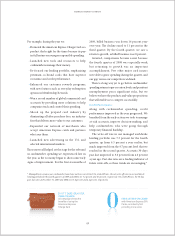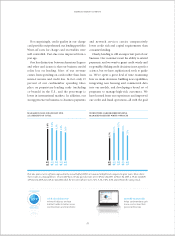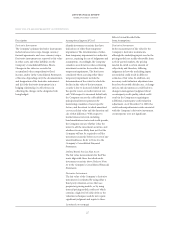American Express 2009 Annual Report Download - page 21
Download and view the complete annual report
Please find page 21 of the 2009 American Express annual report below. You can navigate through the pages in the report by either clicking on the pages listed below, or by using the keyword search tool below to find specific information within the annual report.2009 FINANCIAL REVIEW
AMERICAN EXPRESS COMPANY
service. The expenses that now fall within Global Services
account for just under half of the Company’s consolidated
operating expense. This organization has been tasked with
generating an annualized level of gross expense savings of
approximately $500 million by 2012. It is expected that a
portion of any such savings would be reinvested in growth
initiatives; and
폷Also, as part of the organizational changes, the Company’s
Chief Executive Officer is now working directly with the
leaders of the Global Commercial Card and Global Travel
Services groups on overall strategies to capitalize on
Business-to-Business growth opportunities.
Historically, the Company has sought to achieve a number of
financial targets, on average and over time:
폷Revenues net of interest expense growth of at least 8
percent;
폷Earnings per share (EPS) growth of 12 to 15 percent; and
폷Return on average equity (ROE) of 33 to 36 percent.
In addition, assuming achievement of such financial targets,
the Company has sought to return at least 65 percent of the
capital it generates to shareholders as a dividend or through
the repurchase of common stock.
The Company met or exceeded these targets for most of
the past decade. However, during 2008 and 2009, its
performance fell short of the targets due to the effects of the
continuing global economic downturn. As long as these
difficult conditions persist, it is unlikely that the Company
will achieve all of its on average and over time financial
objectives. The Company’s share repurchase program was
suspended in 2008 and, as a result, the amount of capital
generated that is returned to shareholders has been and will
likely continue to be below the levels achieved earlier in the
decade.
The Company believes it will be positioned, over the long
term, to generate revenue and earnings growth in line with its
historical target levels. However, evolving market, regulatory
and rating agency expectations will likely cause the Company,
as well as other financial institutions, to maintain in future
years a higher level of capital than they would have historically
maintained. These higher capital requirements would in turn
lead, all other things being equal, to lower future ROE than
the Company has historically targeted. While the Company is
not establishing a new target at this time, it currently believes
that it will ultimately be positioned to deliver a ROE in excess
of 20 percent over time. As the capital requirements for
financial institutions become clearer, management will have
greater visibility into this area. At that time, the Company will
provide updated long-term ROE and capital distribution
targets.
BANK HOLDING COMPANY
During the fourth quarter of 2008, the Company became a
bank holding company under the Bank Holding Company
Act of 1956, and the Federal Reserve Board (Federal Reserve)
became the Company’s primary federal regulator. As such, the
Company is subject to the Federal Reserve’s regulations,
policies and minimum capital standards.
CURRENT ECONOMIC ENVIRONMENT/OUTLOOK
2009 was a challenging year characterized by a weak economy,
frozen credit markets in the first half of the year and high
credit losses industry wide. In the first two quarters, the
Company’s spending and cardmember loan balances declined
by double digits as compared to the corresponding periods in
2008 and credit metrics (e.g. past due and write-off rates)
peaked at historically high levels. In the third quarter, the
Company’s credit actions began to positively impact past due
and write-off rates, and spending declines began to become
less severe. The fourth quarter showed greater improvement.
In the fourth quarter of 2009 the year-over-year growth
rate in cardmember spending volumes was positive for the
first time since the third quarter of 2008, benefiting from both
easier comparisons to year-ago billings as well as higher levels
of spending. Improvements in billed business trends were
experienced in all business lines in the fourth quarter. In
addition, for the first time during the year, the growth rate in
both the number of card transactions and average transaction
size were positive in the fourth quarter as compared to the
corresponding period in 2008. Despite these favorable trends,
the Company expects the global economy to continue to
recover gradually and the resulting environment to be
characterized by billings growth that is more modest than it
experienced before the recession, as consumers and businesses
remain cautious about their spending.
The favorable credit trends experienced in the third
quarter of 2009 continued to show overall improvement in
the fourth quarter. Charge card write-off rates and past-due
trends in the United States continued to improve significantly
during the fourth quarter, reaching historic lows by the end of
the year and contributing to lower provision levels.
Worldwide lending write-off rates also continued to decline in
the fourth quarter, improving for the second quarter in a row.
This was driven in part by a broad range of credit and
business actions, such as enhanced credit and collection
policies and practices. Lending past-due trends also continued
to improve in the fourth quarter. If past-due trends,
recoveries and bankruptcies remain stable, the Company
expects managed U.S. lending write-offs in the first quarter of
2010 to be similar to those in the fourth quarter of 2009, and
19
























